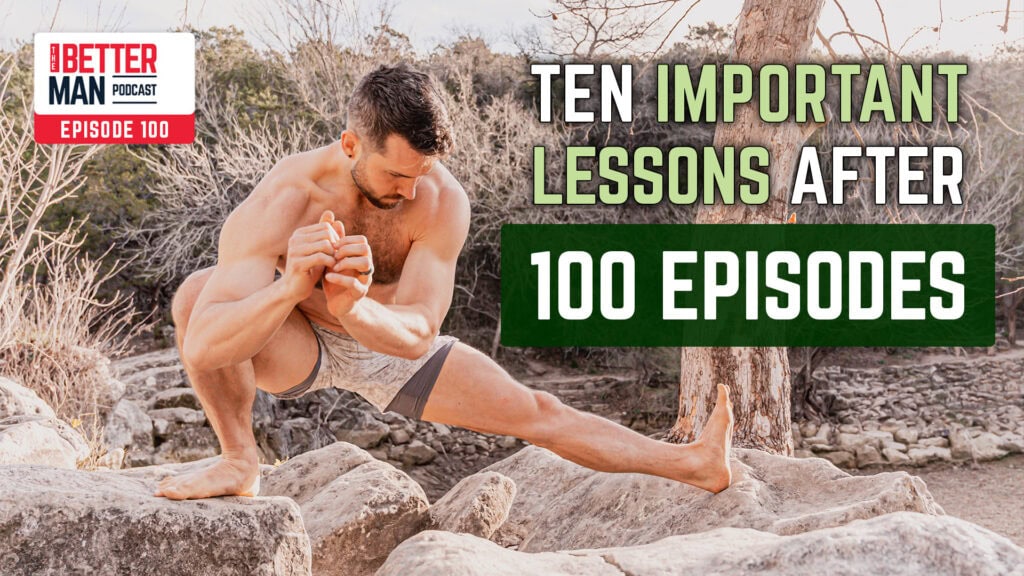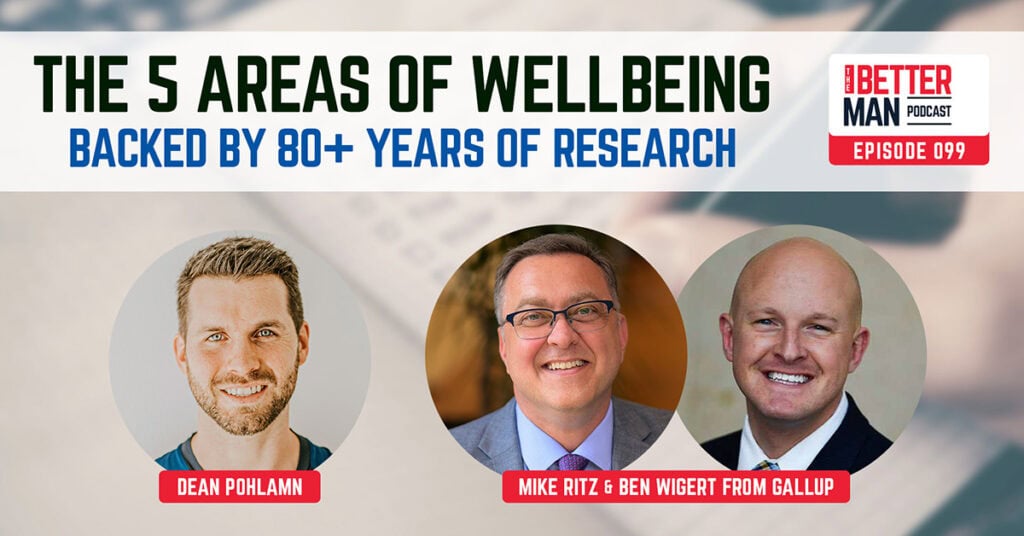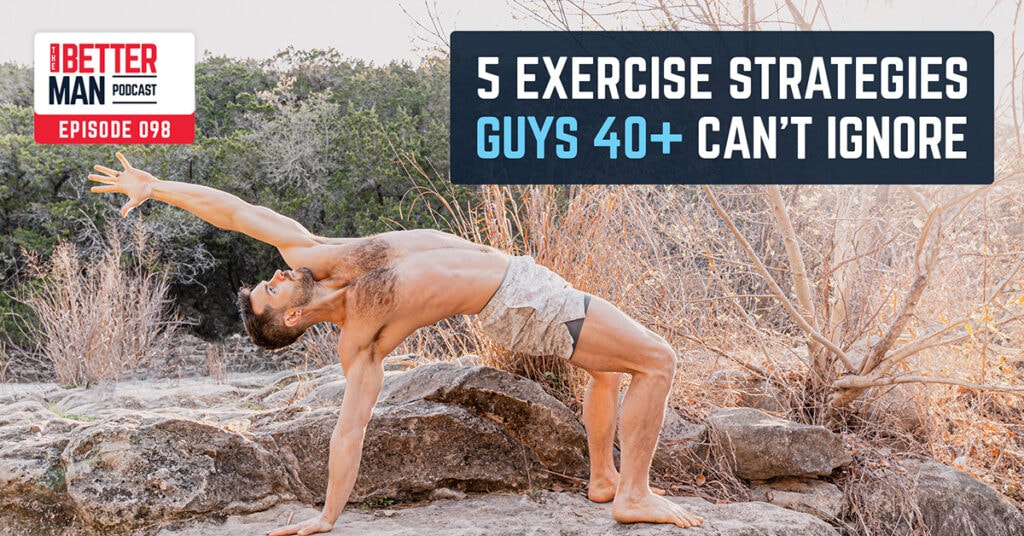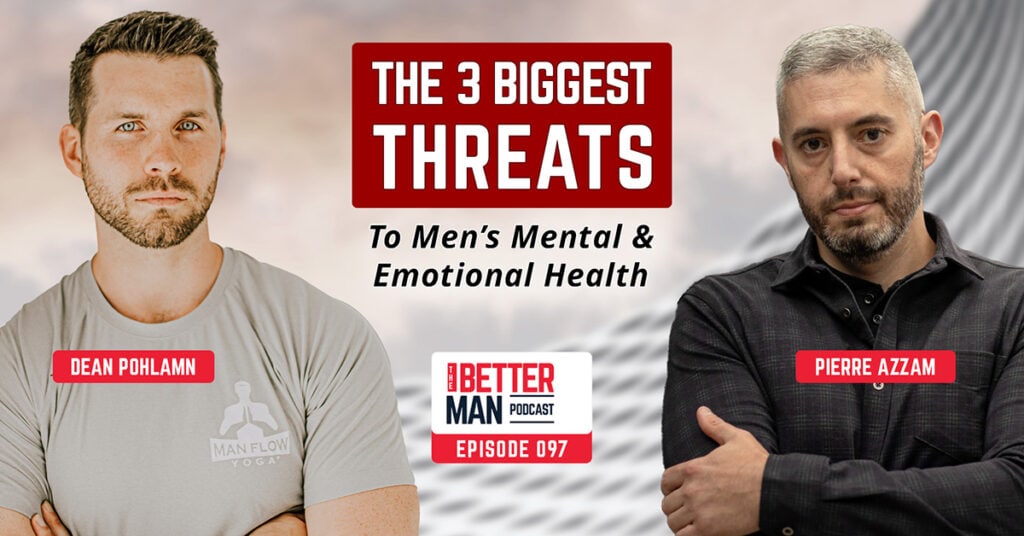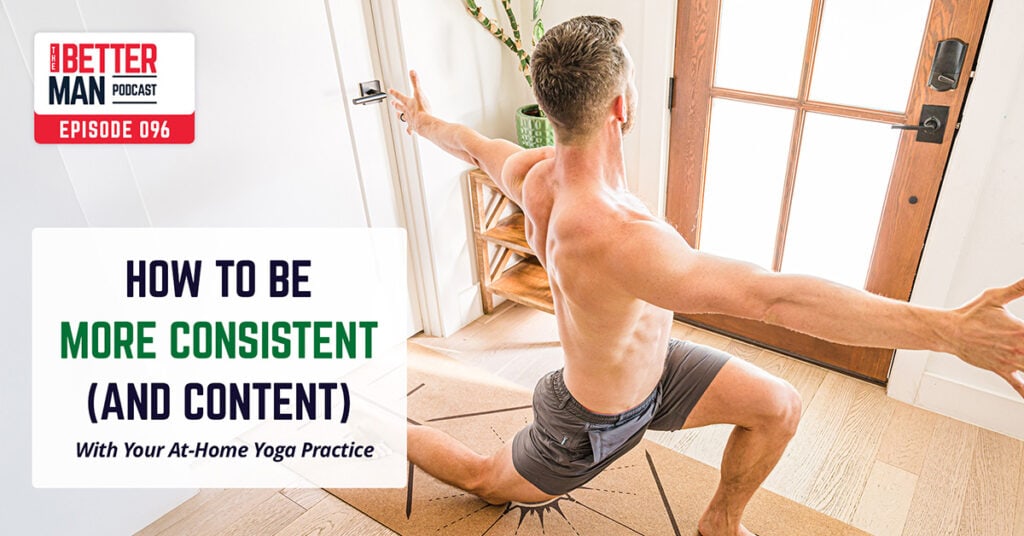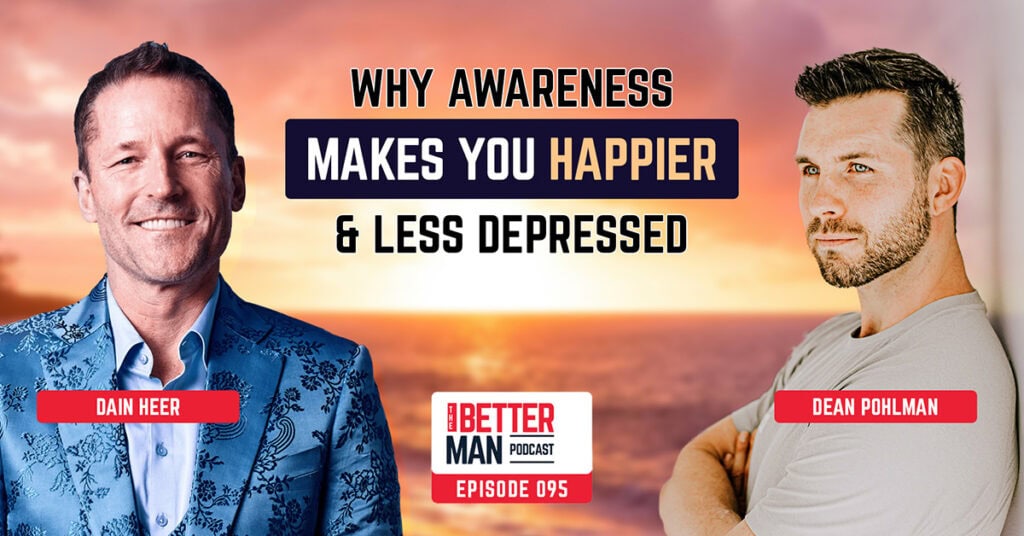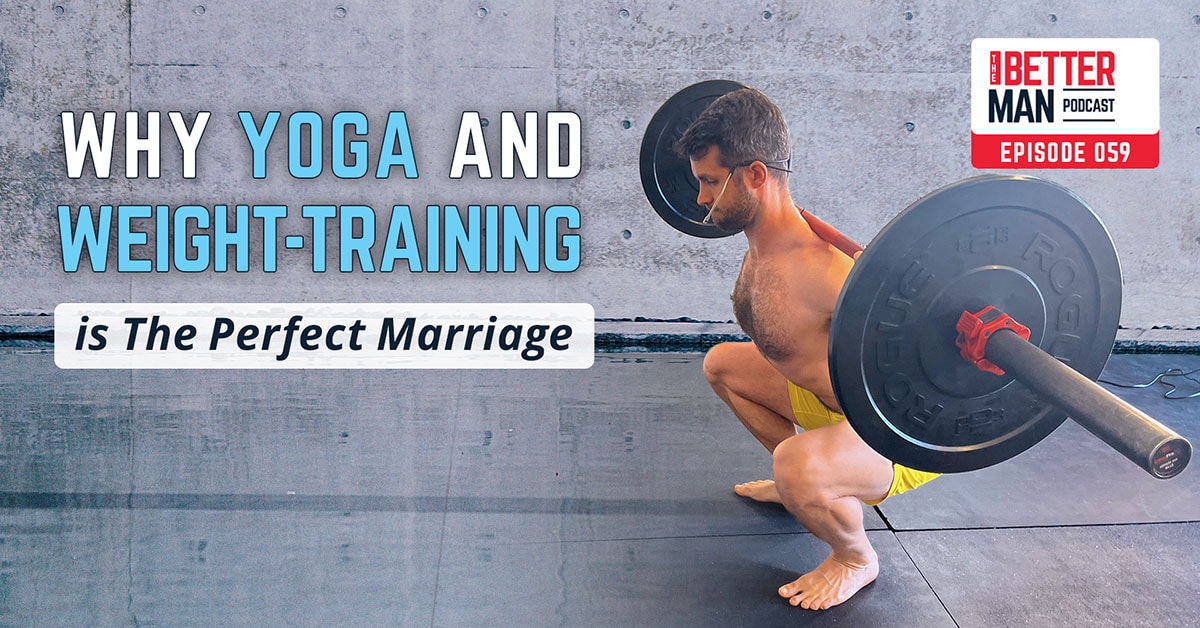Dean Pohlman: Hey, guys, What’s up? It’s Dean. Welcome to the Better Man podcast. Today’s episode is a solo episode, and I’m going to talk about my experience with weight lifting versus no Way lifting. So roughly, this is going to go through a few different phases of my life. We’re going to talk about when I was a high school and college athlete.
Dean Pohlman: So prior to 2012, age 14 through 22, when I was only doing weightlifting and sports specific training as a collegiate lacrosse athlete. And we’re going to talk about when I found yoga and I only did yoga for a few years, that was from 2000, roughly 2012 through 2016. And then we have a some weightlifting and yoga phase, which was from 2000 roughly 2017 to 2020, and then 2021 to present when I am serious with weight training and also doing yoga.
Dean Pohlman: So I think there’s a lot of things to learn from these different phases. I’m going to tell you about my personal experience with those and then try to do it in a way that’s helpful to you so you can understand how much yoga is good and how much weightlifting is good. Is there an optimal blend of them? And I do want to say before I start this, that this is going to largely depend on your current finish fitness interest and your current fitness goals.
Dean Pohlman: You’re not always, at least if you’re like me, there might be periods of your life where you enjoy doing yoga more and there might be periods of life where you enjoy doing weight training more. So it’s not a bad thing to fluctuate between the two. And it’s actually it’s a good thing because your body is going to get a break from certain things as you focus on other things and it’s going to be better for your overall fitness improving over time.
Dean Pohlman: If you do change up the balance of how you do these things. So if you go through a period where you’re doing more weight training and then you go through a period where you’re doing less weight training and more yoga, then that is that’s great. That’s that’s going to help you make sure that you’re continuing to be consistent with your workouts because you’re interested in what you’re doing, because you’re passionate about what you’re doing, instead of forcing yourself to do something that this just not the right phase of you.
Dean Pohlman: It’s just not in the right phase of your life at that time. All right. Let’s get into this, because I know that hopefully you’re you’re interested in this topic and you’re going to get a lot out of this. So let’s let me take you back to a time before the soreness existed, before chronic injuries existed, before a lack of mobility had any meaning whatsoever on your overall movement and your overall health, and that is as a teenager.
Dean Pohlman: So you can pretty much do anything you want as a teenager and get away with it as long as you do not break a bone in the process, you can recover and you can just get right back to what you’re doing. It doesn’t matter if you have a workout and you tweak your back or you tweak your shoulder because three days later it’s going to be fine again.
Dean Pohlman: So when you are younger, you can get away with a lack of mobility, you can get away with a lack of core strength. You can get away with a lack of hip and ankle mobility because your body is going to find a way to work around it. It’s almost as if our bodies evolved to be able to absorb the mistakes, the training mistakes that we make when we’re younger.
Dean Pohlman: The thing the problem is when you get older, you cannot make those same training mistakes and expect your body to be pain free. So when I was younger and I was only weight training, I lifted weights very intensely. I didn’t pay much attention to technique, I didn’t pay much attention to muscle engagement and I was strong, but I still had pretty significant kind of aches as a result of my workout.
Dean Pohlman: I wouldn’t say that I was I had significant, pretty significant pain after the workouts. It was just as I was going through a lot of the movements, they just didn’t feel great. It was almost like I was doing the reps in order to get them done rather than really enjoying the reps. So it was definitely a means to an end.
Dean Pohlman: It was. It was I was doing it because it was fun to be intense, to push yourself hard and to feel strong. But I didn’t pay much attention to technique. I didn’t make sure that I was using full range of motion. So some some examples here. I did a lot of overhead press when I was in high school, but I arched my back in order to do it, so I was basically just pushing with my chest.
Dean Pohlman: I wasn’t using any of the muscles in my upper back. When I did a deadlift, I didn’t use my hamstrings or my glutes at all. I just grabbed the bar and pulled with my low back as hard as I could. And that’s terrible for your back. If you know anything about deadlifting, you know that that is a terrible way to do things.
Dean Pohlman: But when you’re younger you can get away with it. Now when you get older, you try and do that. You’re going to have lower back pain for sure. You might even hurting at a desk in the process, but when you’re younger again, you can get away with it. So fast forward a few years. I’ve been doing weightlifting, I’ve been doing playing lacrosse at the collegiate level.
Dean Pohlman: I’ve had some injuries. I’ve had at this point. I had recurring what’s called recurring knee sub recurring patella subluxation, which basically means that I had weak, tender loose tendons in my knees that caused my kneecaps to partially go in and out. This probably happened, I don’t know, two or three times a year, and it would sometimes take two days to recover from, and sometimes it took surgery to recover from.
Dean Pohlman: So when I was 16 I got surgery and that was at the time when I didn’t realize that there root cause of the issue wasn’t my knees, it was actually weak hips and a weak core and a lack of mobility in my hips and ankles. So I thought that surgery would fix me. I did the surgery and a lot of why I do manual yoga now is because I’ve learned so much about why I didn’t need that surgery.
Dean Pohlman: So I’m trying to put out the right information for people to help help them understand that, hey, it’s probably not your back or your knees. That the problem, the problem is that you have a weak core problem is that you lack mobility. The problem is you don’t do enough of this other stuff that you should be doing this recovery work, this balance, training, flexibility, work to make sure that you’re supporting your joints and building strength and muscles that we tend to neglect.
Dean Pohlman: I also had some rotator cuff issues because I was only training my upper body and pushing exercises. I wasn’t doing enough pulling exercises. I had a a severe lack of shoulder mobility, which is, you know, so a lot of the the irony of what I do now is that it’s addressing a lot of those weaknesses that I had when I was younger.
Dean Pohlman: All right. So let’s fast forward. We’ve gotten through the we’ve gone through the weightlifting phase. We’ve gone through the college athlete phase. And now I found yoga and I’m like, Oh, wow, this is such a great workout. I am working on all of these things that are really challenging for me because I’ve only been doing weight training and sports specific training for the last ten years.
Dean Pohlman: So I was finding all these different movements and it was really challenging and it was hard and I was feeling myself getting stronger. The benefits of being more flexible, of being more mobile and that was a really cool time for me because I still had a lot of the strength that I had from weight training. But now I was integrating this with increased mobility.
Dean Pohlman: So I was noticing that my body felt a lot smoother. I was just movements were easier to do. I was able to I just felt lighter somehow. I was still really strong now. And this is at this time, this was my last season of collegiate lacrosse. So I think the last time I weight lifted was probably January of this would have been 2012th January 2012.
Dean Pohlman: This is my last time weightlifting. And then after that I just did yoga like 5 to 7 times per week. So this is a really cool phase for me because again, I was had the strength from weight training, but I had all of this this mobility and body control and core awareness and core strength from yoga. And so I thought, okay, I’m just going to keep doing yoga.
Dean Pohlman: I don’t need to do strength training. I am an anomaly. The rules don’t apply to me and I will keep my muscle. Now, fast forward a year or a couple of years and I look at myself in the mirror and I realize, Whoa, you have lost a lot of muscle. You do not look the way that you used to.
Dean Pohlman: And I was okay with it because my goals at the time were to work more on getting better at yoga, getting more flexible, being able to do imbalances, you know, being able to look cool on Instagram. So that was okay with me. That was my goal at the time. And and I felt I felt pretty good. I was doing a lot of yoga during this time.
Dean Pohlman: Like, you know, I was also in addition to doing it on my own, I was also teaching yoga. That was as I was kind of as I was kind of, you know, building man for yoga. I was doing a lot of in-person things. I was doing a lot of private lessons. I was doing small group lessons. I taught at some gyms, some studios, one studio, mostly I taught at gyms.
Dean Pohlman: And so I was doing three or four yoga sessions a day. I was doing a lot, and that meant that I had very little muscle mass because when you’re doing yoga that much and you’re not doing traditional strength training, you’re not doing, you know, body weight, you’re not doing reps, basically that means that you’re not going to have a lot of muscle.
Dean Pohlman: So I was very toned. I think I had a decent amount of, you know, I looked strong, but I did not have a ton of strength and I had a lot less muscle mass than I used to. And a couple of years of this went by and I went to play in the lacrosse world Games in 2014. I was a long story, but I was affiliated with Turkey Lacrosse and I’m not Turkish, but I spent some time working in Turkey and I lived in Turkey in some immersive, immersive language programs from 2010 to 2012.
Dean Pohlman: And I went to the World Lacrosse games and I got injured. I think my third or fourth game had a really bad the same episode that I had before when I was a kid, when I was when I was a collegiate high school athlete. I had my knee, you know, kind of went out of place. And this was one of the worst, worst episodes of this.
Dean Pohlman: I had had. So I took me about six months to recover from this. And it it sucked. And the reason why I got that injury was because I wasn’t doing any weight training, I wasn’t doing any sports specific training. I just assumed that because I was doing yoga, I was covering my fitness bases and I’d be able to, you know, go out and play lacrosse and do it injury free.
Dean Pohlman: And the reality was that I had a lot of instability in my body. My knees were weak because I wasn’t doing squats with weights, I wasn’t doing sports, I wasn’t sprinting, I wasn’t doing like all of these things that I should be doing in order to be able to go out to a lacrosse game and play at the highest level that I could.
Dean Pohlman: And the result was that I got injured. So big lesson here is you need to train for your activity of choice. I also learned that I’m not an anomaly, so I can’t get away with not working out and just I can’t get away with not lifting weights and not training for my sport and expect that my body can perform.
Dean Pohlman: So that was humbling. But it did teach me that, you know, yoga is not the end all, be all for fitness. So 2016, I think was the year 2017. I can’t remember for sure when, but I had this moment where I went to a group fitness class and I was I just sucked. I had no endurance. I couldn’t do the exercises that everyone else was doing.
Dean Pohlman: And I looked around the room and I was like, I think I’m in better shape than these guys, but I cannot do the full duration of this exercise. I can’t I can’t go through a boot camp style workout because all I do is yoga. And I at the end of the class, I remember there was a guy who’s like, he’s doing an arm bounce.
Dean Pohlman: It’s like, I’m going to do an arm balance. And I tried to do it and I just felt so weak in my upper body. I couldn’t do it because I wasn’t doing arm balances anymore. I was just doing yoga workouts, I was doing planks, I was doing Chaturanga, so yoga push ups, but I wasn’t doing things that demanded a lot of strength for me.
Dean Pohlman: And yeah, I looked good in the mirror like I looked very toned. But actually at the time I was about 5% body fat. I’m not saying that to brag. I’m saying that because it was a very low percentage of body fat and I wasn’t that strong. If you’re trying to get jacked or you’re trying to get really skinny, what I did basically I had a lot of muscle and then I stopped eating carbs and I started only doing yoga.
Dean Pohlman: And what happened was I lost a significant amount of that muscle, but I also lost all my fat. So I looked really toned, but I wasn’t that strong. I didn’t feel that great. I had a somewhat lower sex drive. I was hungry very often throughout the day again, and I had no performance when it came to be able to do workouts with endurance.
Dean Pohlman: So this workout was the event that caused me, okay, it’s time for me to get back to weight training. I’m going to start weight training in on my own. I’m going to start integrating all this stuff that I learned with yoga, with weight training. I think the funny thing about this was that as I was doing so much yoga, a lot of the reason why I did it was because I, I wanted to address the imbalances and the weaknesses that cause me to have issues with strength, with strength training in the first place.
Dean Pohlman: So I was doing yoga and I was doing, you know, this kind of yoga that I developed called Man for Yoga to work on all of the weaknesses that made weightlifting difficult, things difficult for me. So I was really pushing muscle activation in your glutes. I was really strengthening my core. I was working on getting my hip flexors involved, getting my upper back muscles involved, scapular stability, all of these things that help with weight lifting.
Dean Pohlman: But I wasn’t actually doing weightlifting, so I was like, okay, I have to put this stuff into practice. I have to start weightlifting and integrating this. And for I think I think the thought was that I just need more time. I just need more time preparing my body and then I’ll get ready. I have this I have this thing where I overprepare for things instead of just doing them.
Dean Pohlman: And and I’m telling you that because you don’t need to spend two years rehabbing your body before you start doing what you want to do. For a lot of people, I was for most people who do man for yoga, if you spend two months or six weeks or better yet, let’s say three months focusing on what we do in man for yoga, building the right muscle activation, working on your functional mobility, you can get back to what you enjoy doing much sooner, right?
Dean Pohlman: So three months of just man for yoga corrects some imbalances, work on some of those weaknesses that most of us have, and then get back to what you enjoy doing and you’re going to notice a huge difference. And for me, I just took too long of a break. I took like four years off from weightlifting, five years, whatever it was, because I was like, I’m just preparing my body, I’m just preparing my body.
Dean Pohlman: And so 20, 17, 15, 16, whatever year this was, I finally started lifting weights again. And I, you know, muscles started coming back. I started feeling stronger. I started feeling more capable. I started feeling more confident myself in the mirror. And and that was good. So I started to, you know, I started to build some more muscle and then I felt like I just wasn’t I felt like I just wasn’t progressing the way that I wanted to.
Dean Pohlman: I needed more help. I wasn’t very consistent with weightlifting. I kind of did it once or twice a week, and I was still mostly doing yoga. And I just I don’t know, I just wasn’t where I wanted to be with my body. I felt like I still felt like I wasn’t me in this body. And so at the end of 20, near the end of 2020, I was like, okay, it’s time to get serious.
Dean Pohlman: And I found a coach to actually give me scheduled workouts to build out a program for me. If you’re wondering who did this, I work with Central Athlete. My trainer’s name is Jesse O’Brien. We’ve actually referred a lot of people for mental yoga over there. We had a really cool group program. I think we did this twice where we had ten guys from Enfield all go through this group, kind of remote weight training, a resistance training program to get people started with weight training.
Dean Pohlman: So anyways, my trainer is Jesse O’Brien. He’s been on a couple podcast episodes. You can check those out on the Better Man podcast from season one. And then I was actually doing weightlifting weightlifting consistently three times per week, and I was really good about that for the first year. And then I had some on and off periods. You know, things just came up.
Dean Pohlman: I think I had my I had a I had a child. So that was that that that could derail it. And then I also ended up getting some pretty significant low back pain. ASAAD That I did a whole podcast on this, but basically compounded by a summer of traveling, getting COVID, losing a lot of muscle and not being able to, and then moving right after having COVID and then like making my back worse with that.
Dean Pohlman: And so anyways, it took a couple of months, a few months to recover, and I did the weightlifting that I could. But the point is that anyways, roughly from January 2021 through present, I have been doing three intense weightlifting or resistance training sessions per week and then also doing yoga around that. So as far as the yoga that I do kind of with my weight training now, I, I found that for me the best way to do this is to do 2 to 3 medium to longer yoga sessions per week.
Dean Pohlman: And then I do short to medium yoga sessions probably 3 to 5 times per week. And then I’ll also do some and I’ll do those in the morning or kind of to break up the day, and then I’ll also do some evening stretching. So when I’m just like in front of the TV or by the couch at the end of the day, then I’ll do some stretching in front of the TV or some foam rolling, whatever my body kind of needs that day.
Dean Pohlman: If I sat a lot that day or if I had a workout the previous day or even that day. And I’m trying to be proactive and make sure that I don’t get sore, then those are. So that’s how I’m doing yoga with weight training and and with those two or three medium to longer sessions, those are when I’m pushing my yoga workouts.
Dean Pohlman: That’s what I’m doing, challenging yoga workouts, and those will typically take 40 to 60 minutes. So and those are all just kind of self-directed. But I tell you all these things too, because there is a there is a balance. There is just kind of an art to finding a balance between the amount of yoga and the amount of weight training that you do.
Dean Pohlman: If all you do is yoga, you’re going to feel good initially. But eventually the lack of strength training is going to leave you feeling weak. You’re just not going to feel at your best. And the thing about only weight training is you don’t have mobility and your body’s just going to be in pain all the time from your strength training, workouts.
Dean Pohlman: So you need to do yoga to help with your strength training and you need to do strength training because if you don’t, you’re going to feel weak. So finding the balance of these two things, the easiest way to do that is to just do three days of weight training and then three days of yoga on other days. For me, it’s a little more complicated because, you know, this is what I do.
Dean Pohlman: So it’s easier for me to to make things more complicated. But I typically like to do yoga in the mornings, just a quick few poses, not like a super intense 30 minute session, but maybe just 10 to 20 minutes. And then when I do my my main yoga workout, I do those on non weightlifting day. So I’ll do those in the afternoons typically and those will be anywhere from 30 to 60 minutes.
Dean Pohlman: Just depends on what my body’s feeling that day. I’ll also combine that with foam rolling with mobility work as needed, maybe even some resistance bands, things like that to to target some specific muscles that needed some extra love. And then those three weightlifting sessions for a week, those are pretty those are pretty non-negotiable for me. But again, if I’m not doing yoga, if I’m not doing mobility work, then the weightlifting sessions start to hurt.
Dean Pohlman: And that’s when I realize, okay, like I’m slacking off my yoga, I need to do that. And so, you know, so so this is just is just to say, like, if you’re doing a lot of weight training and you notice, like, hey, like these I’m not really enjoying this as much. Like, I feels like I’m just getting through the workouts instead of enjoying the workouts, then it’s a good idea for you to start working more on your mobility.
Dean Pohlman: And if you’re doing a lot of yoga and you’re not feeling sore from your workouts and you’re noticing that lifting things is difficult, if you’re noticing that you’re losing muscle mass, then hey, it’s a good idea to start doing some strength training. And also it just in general, we need we need the exercises from both practices in order to be strong.
Dean Pohlman: If you’re only doing yoga and bodyweight exercise, you’re not strengthening your upper back and your shoulders. So there’s no way for you to build strength in your upper back without using some form of resistance, whether that’s a pull up bar so that you can get those muscles working, or if it’s just resistance bands or weights, but you cannot strengthen your upper back.
Dean Pohlman: With yoga alone, there’s just no way to mimic pulling with your body weight. So that’s why it’s really important to strength training. And then for yoga, you need to be doing that because that’s going to help with your mobility, that’s going to help with your recovery. And also most of us spend a decent amount of time being sedentary and we’re driving long distances, We’re commuting, we’re also sitting at a desk.
Dean Pohlman: And so we need to do the right exercises to undo the stress of those things on our body. And if all you do is weight training, you’re not doing enough to undo the effects of a sedentary lifestyle. So that’s what I have to say about weightlifting and yoga. Again, you’re going to go through phases where you’re more interested in weightlifting.
Dean Pohlman: You’re going to go through phases where you’re more interested in yoga, and that’s fine. I would lead with whatever you are most excited about when it comes to your fitness, because you want to be excited about it. You don’t want to dread your workouts. So you know, if you’re going through something and another program comes up and you’re like, Hey, this makes me really excited.
Dean Pohlman: I’m going to do this, then that’s great. I think you should do that. I do think there should be like a fair level of consistency for a duration of time. So I would stick with things for at least four weeks. You know, if you switch your workout every day, you know, it might be fun. But I think you’re going to be frustrated with not seeing progress and things if you’re just doing a bunch of random workouts.
Dean Pohlman: So it’s helpful to have a plan for, you know, four weeks at a time at a minimum. And then you can change things up. But I do think that it’s it’s totally fine if you go through periods where you want to do more yoga or periods where you want to do more weight training, I do think you need to do both in order to keep your body feeling strong.
Dean Pohlman: Yoga is something that you can do every day. Weightlifting. You really don’t need to do more than two or three times per week. You know, there are people who do five or six times for a week, but you don’t need to do that unless you know you’re training for something or you’re trying to be a bodybuilder or, you know, or you really enjoy it.
Dean Pohlman: If you enjoy it, then great, do it. But for most people, you don’t need to do any more than 2 to 3 times per week. And yoga is cool because you can do it every day. You can do it multiple times per day and your body feels better the more you do it, depending on the intensity. So. All right, guys, anything beyond this, I think I’m going to be rambling, so I’m going to end it here.
Dean Pohlman: I hope you enjoyed this. So a podcast from The Better Man podcast. I hope you’re enjoying these episodes if you haven’t already, please consider leaving a review for us on Apple Podcasts. You can also do that on Spotify. Say something nice about me pretty please. And then if you haven’t already gotten started with meaningful yoga, we have a free seven day trial.
Dean Pohlman: M-F Why not TV slash join programs, workouts, tutorials and a whole getting started series to walk you through how to be consistent program progression. Lots of really cool stuff that makes it as easy as we can make it to be successful with our online program. And then if you are not quite ready to do a trial, we do have a free seven day challenge which you can sign up for to begin a sugar free man challenge 15 minutes per day.
Dean Pohlman: Sign up for that at manvel yoga dot com slash seven DC All right, guys, thanks for listening to this episode. I hope you got something out of this and I’ll look forward to hearing you. I look forward to seeing you on the next one. Bye.
[END]



